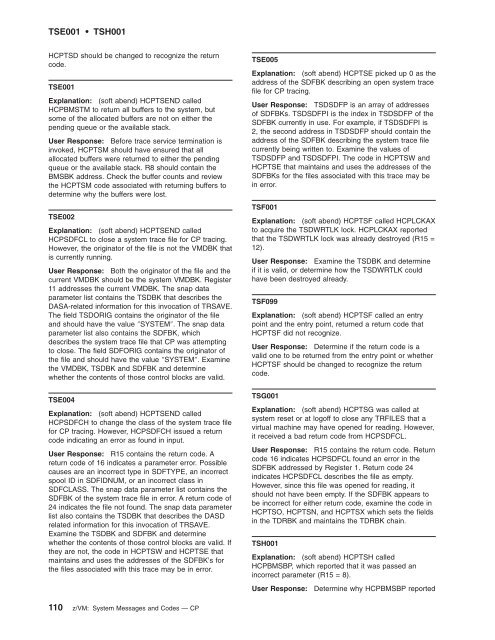z/VM: System Messages and Codes Š CP - z/VM - IBM
z/VM: System Messages and Codes Š CP - z/VM - IBM
z/VM: System Messages and Codes Š CP - z/VM - IBM
You also want an ePaper? Increase the reach of your titles
YUMPU automatically turns print PDFs into web optimized ePapers that Google loves.
TSE001 TSH001<br />
H<strong>CP</strong>TSD should be changed to recognize the return<br />
code.<br />
TSE001<br />
Explanation: (soft abend) H<strong>CP</strong>TSEND called<br />
H<strong>CP</strong>BMSTM to return all buffers to the system, but<br />
some of the allocated buffers are not on either the<br />
pending queue or the available stack.<br />
User Response: Before trace service termination is<br />
invoked, H<strong>CP</strong>TSM should have ensured that all<br />
allocated buffers were returned to either the pending<br />
queue or the available stack. R8 should contain the<br />
BMSBK address. Check the buffer counts <strong>and</strong> review<br />
the H<strong>CP</strong>TSM code associated with returning buffers to<br />
determine why the buffers were lost.<br />
TSE002<br />
Explanation: (soft abend) H<strong>CP</strong>TSEND called<br />
H<strong>CP</strong>SDFCL to close a system trace file for <strong>CP</strong> tracing.<br />
However, the originator of the file is not the <strong>VM</strong>DBK that<br />
is currently running.<br />
User Response: Both the originator of the file <strong>and</strong> the<br />
current <strong>VM</strong>DBK should be the system <strong>VM</strong>DBK. Register<br />
11 addresses the current <strong>VM</strong>DBK. The snap data<br />
parameter list contains the TSDBK that describes the<br />
DASA-related information for this invocation of TRSAVE.<br />
The field TSDORIG contains the originator of the file<br />
<strong>and</strong> should have the value ″SYSTEM″. The snap data<br />
parameter list also contains the SDFBK, which<br />
describes the system trace file that <strong>CP</strong> was attempting<br />
to close. The field SDFORIG contains the originator of<br />
the file <strong>and</strong> should have the value ″SYSTEM″. Examine<br />
the <strong>VM</strong>DBK, TSDBK <strong>and</strong> SDFBK <strong>and</strong> determine<br />
whether the contents of those control blocks are valid.<br />
TSE004<br />
Explanation: (soft abend) H<strong>CP</strong>TSEND called<br />
H<strong>CP</strong>SDFCH to change the class of the system trace file<br />
for <strong>CP</strong> tracing. However, H<strong>CP</strong>SDFCH issued a return<br />
code indicating an error as found in input.<br />
User Response: R15 contains the return code. A<br />
return code of 16 indicates a parameter error. Possible<br />
causes are an incorrect type in SDFTYPE, an incorrect<br />
spool ID in SDFIDNUM, or an incorrect class in<br />
SDFCLASS. The snap data parameter list contains the<br />
SDFBK of the system trace file in error. A return code of<br />
24 indicates the file not found. The snap data parameter<br />
list also contains the TSDBK that describes the DASD<br />
related information for this invocation of TRSAVE.<br />
Examine the TSDBK <strong>and</strong> SDFBK <strong>and</strong> determine<br />
whether the contents of those control blocks are valid. If<br />
they are not, the code in H<strong>CP</strong>TSW <strong>and</strong> H<strong>CP</strong>TSE that<br />
maintains <strong>and</strong> uses the addresses of the SDFBK’s for<br />
the files associated with this trace may be in error.<br />
110 z/<strong>VM</strong>: <strong>System</strong> <strong>Messages</strong> <strong>and</strong> <strong>Codes</strong> — <strong>CP</strong><br />
TSE005<br />
Explanation: (soft abend) H<strong>CP</strong>TSE picked up 0 as the<br />
address of the SDFBK describing an open system trace<br />
file for <strong>CP</strong> tracing.<br />
User Response: TSDSDFP is an array of addresses<br />
of SDFBKs. TSDSDFPI is the index in TSDSDFP of the<br />
SDFBK currently in use. For example, if TSDSDFPI is<br />
2, the second address in TSDSDFP should contain the<br />
address of the SDFBK describing the system trace file<br />
currently being written to. Examine the values of<br />
TSDSDFP <strong>and</strong> TSDSDFPI. The code in H<strong>CP</strong>TSW <strong>and</strong><br />
H<strong>CP</strong>TSE that maintains <strong>and</strong> uses the addresses of the<br />
SDFBKs for the files associated with this trace may be<br />
in error.<br />
TSF001<br />
Explanation: (soft abend) H<strong>CP</strong>TSF called H<strong>CP</strong>LCKAX<br />
to acquire the TSDWRTLK lock. H<strong>CP</strong>LCKAX reported<br />
that the TSDWRTLK lock was already destroyed (R15 =<br />
12).<br />
User Response: Examine the TSDBK <strong>and</strong> determine<br />
if it is valid, or determine how the TSDWRTLK could<br />
have been destroyed already.<br />
TSF099<br />
Explanation: (soft abend) H<strong>CP</strong>TSF called an entry<br />
point <strong>and</strong> the entry point, returned a return code that<br />
H<strong>CP</strong>TSF did not recognize.<br />
User Response: Determine if the return code is a<br />
valid one to be returned from the entry point or whether<br />
H<strong>CP</strong>TSF should be changed to recognize the return<br />
code.<br />
TSG001<br />
Explanation: (soft abend) H<strong>CP</strong>TSG was called at<br />
system reset or at logoff to close any TRFILES that a<br />
virtual machine may have opened for reading. However,<br />
it received a bad return code from H<strong>CP</strong>SDFCL.<br />
User Response: R15 contains the return code. Return<br />
code 16 indicates H<strong>CP</strong>SDFCL found an error in the<br />
SDFBK addressed by Register 1. Return code 24<br />
indicates H<strong>CP</strong>SDFCL describes the file as empty.<br />
However, since this file was opened for reading, it<br />
should not have been empty. If the SDFBK appears to<br />
be incorrect for either return code, examine the code in<br />
H<strong>CP</strong>TSO, H<strong>CP</strong>TSN, <strong>and</strong> H<strong>CP</strong>TSX which sets the fields<br />
in the TDRBK <strong>and</strong> maintains the TDRBK chain.<br />
TSH001<br />
Explanation: (soft abend) H<strong>CP</strong>TSH called<br />
H<strong>CP</strong>BMSBP, which reported that it was passed an<br />
incorrect parameter (R15 = 8).<br />
User Response: Determine why H<strong>CP</strong>BMSBP reported

















